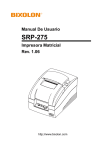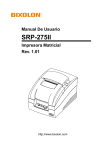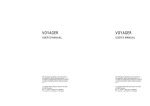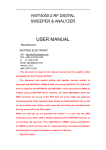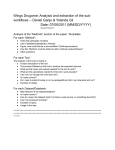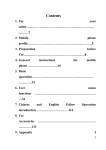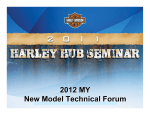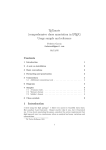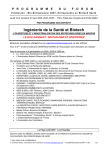Download Gosh, what all had happened since 2004
Transcript
This is the speech I in 2044 would have given at the 80 year anniversary of the Swedish Society on Technical Communications (FTI in short), if I hadn’t been unable to attend. I presented it at the FTI 40 year aniversary in March 2004, asking the audience to imagine they were present in spring 2044. May I ask you to imagine you read this in the year 2044. Gosh, what all had happened since 2004 A review of all that happened between 2004 and 2044 must of course be both rapsodic and subjective. So much have happened. Still so much remain the same. I will try to concentrate on what has been important for us as technical communicators. I will bring up some developments in technology which have given us better working conditions, change in society creating new needs and new work tasks. Also I will bring up something about education and development of technical communicators. I also have a few words about our FTI society. May be I even will get time for some forecasts on the future. Unhealthly work tools The primitive work tools we had at the turn of the century often caused us pain and injuries. Those of us working at that time sat in front of small 27 inch screens and typed in text by tapping our fingertips on knobs labeled with letters. We drew pictures with the help of a pen on a tablet or even with a small roller box (called mouse, you may have seen one at a museum) at the same time staring at a screen. Naturally we got occupational injuries such as pain in neck, back, shoulders, arms and hands. A verry common injury was called ”mouse arm” and was both hurting and degrading the ability to work. I am sure the technical communicators at that time would have been overjoyed if they had been able to use our present tool such as wall screens and talk to text. Being able to move freely in front of a big wall screen instead of being locked in front of a small scren. Being able to draw on the wall screen just by moving your finger over it, or as I myself prefer, at a few meters distance control the drawing process by small finger movements. Being able to give the commands and the text needed in speech. All this give today’s technical communicators a freedom of physical movement our collegues didn’t have 40 years ago, eliminating the injuries earlier geberations of communicators got from the static working position. Besides, many people do in fact think better when they are able to move around. When the possibility for speech to text arrived it was perfect for those of us who mainly produced pictures with short texts. However, those who still thought they needed massive text had some problems. I had a friend who was managing a group of 25 editors at IBM in the US. He was extremely unhappy when all the program developers delivering text to him could start to produce it by speech instead of by typing. He complained that the text produced in this way was even more of an unstructured drivel than he received before. I suggested he could use a method I had practiced myself, to give them questionaires to fill in instead. Then at least you get a proper structure of the material. At the turn of the century we also had some problems with computer programs. Every version became more and more complex. Word processor programs had 1 500 functions, half of which seemed to be there for shutting down all the automatic functions you didn’t like to use. Today it is very simple to build your own program with the modules you need and it is also possible train the programs to suit you better. Instead of having to learn all sorts of tricks to be able to handle the programs they now learn to adapt to us and our needs. Near the task A good principle for technical information is to put it as close to the task to be performed as possible. This became easier to accomplish when in the middle of the 2010’s pocket computers and eye screens came more into use. To get the needed information direct in your line of sight when you for example were servicing a machine was good. However, in the beginning they often made the mistake to project pages from the service manual into the service technicians line of vision and those were not the thing you wanted to have whirling around when working with the machine. I myself participated in an early experiment to try out the method we use nowadays. We were a bit to early, so in spite of using a stationary computer (a liquid cooled Mac G7 with 16 parallell processors, an awesome machine at that time) we had enormous problems to manage even the most primary functions: to get the picture projected into the service tecchnician’s eye always to be loocked to the machine in question in spite of how he moved around the machine and in spite of how he moved his head or what he looked at. (We experimented with a rather big and complicated packing machine where you needed to move around very much to accomplishe the task.) My part of the experiment was primarily to decide how much and what information that should be shown and how it should be designed. We found that you can accomplish the task with much less information when you effectively in the picture overlayed the machine in question can point and demonstrate (by animation). Combined with speech from the computer we got a system being able to act as a human tutor or assistant. More sensitive machines At the turn of the century someone said that the problem with machines is that they can’t blush. Thanks to the incorportation of more sensors and more display techniques from the 2010’s onwards it is easier for the machines to adapt to humans. Nowadays they even can blush. However, people still blame themselves when the cooperation between man and machine doesn’t work. Maybe, they don’t want the machines to ”lose face”, especially machines from the far east. A less pleasant technical development is the strong increase of emotional, idealistic, and commercial malware we have had since the 2010’s. One thing we have learned from this trend is that certain things can’t be informed away. Instead we need to design firm and multilayered barriers. HSS out, HR in During the last 40 years we have certainly seen big changes in the society. Most dramatic possible when we in 2038 understood that a new species of humans had evolved. Li Goutau then presented genetic evidence that Homo Sapiens Sapiens had got strong competition from the new Homo Rapidens, the rapid human. Of course he got the Nobel Price in medicin or physiology for that discovery already the next year. Well, a new human species dosn’t evolve during one night. Already two hundred years ago wise social conservatists warned that humans should be harmed by travelling as fast as 30 km/h on the new railways. We ourselves ought already during the end of the last century have noticed that someting was going on. Right in fron of our eyes we had lots of indications that something was changing. For example, people got very irritated when they had to wait seconds for the computers to finish a task or for the advertisments on the net pages to let the information get through. The big increase of abbreviations in the later part of the 20th century was of course also a sign that something was going on. To these signs we may also add that so many people didn’t read manuals if it all could be avoided. At the turn of the century more people was affecting by interactive voice response systems (when you were trying to reach something by a telephone and were asked by a machine: ”for simple question press 1, for more difficult question press 2”, and so on until ”for contact with operator press 9”). Some people didn’t even manage this first menu level and many more gave up when they reached level 2 or 3 in the menu system. We also found that the time aspect was essential for speech outputs from machines, when we got more such systems. So we were forced to speed up the speech messages to make them sound as if it were from a reporter at an ice hockey match. If not, we found that the listener very easily turned off the hearing and started to think of something else. Technology is not culture Everything is culture, except technology. That was a very common conception at the turn of the century, at least in Sweden. Technology was something created by witchcraft in Santa’s workshop. Besides it very often didn’t work. However, it took until 2013 before a majority in the Swedish parliament decla- red that technology is not culture. (Possibly they had consumed too much whirled water, after having installed such a system in the parliament building at the turn och the century.) We had to live with the consequences of this well into the 2020’s. The parallell economy and the lacking ability to live up to election promises marginalized however gradually the political authority. From the 2020’s the main industry in Sweden became comfort ascertainment and home improvement. Technical communicators contributed with instructions for do-it-yourself tasks. An idea from the late 20th century has first in our days been brought to life: to assemble home, work and leasure to the same geographical location. We now have local workshops which can produce and repair the most we need locally. We have knowledge centers where individuals can work with their own tasks in virtual companies staffed by individuals living all around the world. Still they have other human beings near at hand. And in the area coffea houses they all can meet and chat. Travel allowances In 2026 travel allowances were introduced, mainly to reduce the risk for pandemies. As for the emission allowances they could be sold and bought. This resulted in more use of rapid digital connections and less personal travelling. As more work were done in cooperation with people in other time zones the old system with common working hours between 9 and 5 was abandoned. Instead we got the asynchronous society in which people could do anything at any time, day or night. The only thing that still can synchronize almost everyone is world sporting events. The fast electronic connections also resulted in the piraya economy where small but knowledge intensive companies in shoals very rapidly could create entirely new products and kick bigger companies out of their main markets. Push jobs became also more frequent. Hard work for a couple of days or weeks and then a longer time for rest. However, this time for rest is needed because self service has spread to new areas: waste sorting, snow removal, street cleaning, area security patrol, care of old people – even care of our own children. Important EU directive As early as 2012 we got one of this century’s most important laws: the EU directive on technical manuals. For us it has become a self evident base for all our work with technical information. However, when introduced it was met by great doubt. To say that priority one is to try to design the machine in such a way there is no need for a manual, that was seen as a crazy idea, not possible to accomplish. The second hand alternative, that the manual should be integrated into the product, was met by doubt. People wouldn’t accept that enough information could be given by signs, speech, visual signals and screen information. However, the directive had a third alternative. You could deliver a separate manual, but then you had to give a clear warning already at the package: ”You need the manual to use this product!” The market people protested of course. Today we laugh at these reactions. However, we have to look at them in perspective. Neither the machines, nor the technical information were at that stage as developed as they are today. New tasks We now as technical communicators work with partly other tasks than 40 years ago. Cooperation between companies in ever new constellations puts high demands on rapid, easily understandable information. Many technical communicators do a tremendous important job to synchronize those companies. Others work in local knowledge centers where they answer questions from the public. Thanks to videphone they can give instructions not only by words but they can also demonstrate and point. Some of us took up the important task of giving basic knowledge to non-engineers to give them a frame of reference they need to survive in a world build on technology. The methods we use will give them experience in a pleasant way with the help of games and simulators. However, this couldn’t be done until we accepted that there are several levels of understanding between not being able to understand at all and to be able to optimize a construction. Difficult to handle At the turn of the century feelings among many people was impatience and frustration. The impatience was probably due to the rise of Homo Rapidens. The frustration was more due to the fact that many technical products in fact were difficult to handle. In the late 2010’s I met a usability expert. She said: ”It’s extremely simple to find out which handling problems a certain machine has. You just read the user and service manuals, there you find them page up and page down.” Easier to handle In the beginning of this century very much interest was concentrated around appearance design. In the 2010’s more people understood that complex products need interior ”beauty” design. As it was said: beauty comes from inside. Nowadays the ”obvious principle” is well known. I guess everyone has heard the standard example to use a ”slurp” sound to indicate that a fluid is running short. Sometimes this is called the ”of course” principle, because when you at last find the solution you say: of course. It wasn’t fair to blame the designers for the products’s handling problems. They have so much more to do than to make the products easy to handle. The design must function technically, be able to be rationally produced, not obviously break any law, be less expensive than the competitors’, be fast on the market and in accordance with the market people’s wishes have as many functions as possible. However, both technical communicators and usability experts have been able to help in making products easier to handle, when we were able to be involved early enough in the developping process. It was a flop In the middle of the 2010’s I became involved in a product development with rather typical problems. A company planned to exploit people’s fear for electromagnetic radiation. The developers had designed a 10x7 cm box with a small screen on which you could read out field strength, frequency spectrum, modulation mode, source direction, received time dose and chosen alarm level (and some other functions I don’t remember any more). Functions and alarm level were chosen with the help of three buttons which had to be pushed and kept pushed in various combinations. I was asked to produce a manual (however, the developer who hired me may have had other intentions, he had participated in one of my courses on how to design easy handable products). Together we designed an alternative product. A 4 cm locket you could hand in a chain around your neck. The buyer could choose between a few different versions with different fixed alarm levels. The energy needed for the device was generated from the skin temperature of the user. Alarm was indicated by an electrically created tingling in the skin. If you took the locket in your hand it detected this (piezoelectric sensor) and showed direction to the radiation source with the help of light emitting diodes. The rest of the development team disapproved instinctly to our proposed solution and when the market people found it too simple the decision was to use the original box design. Of course, it was a flop on the market. This was before it from the humanware people overseas came signals that simpler products are better, or as they said: ”Unlimited possibilities limits the user’s possibilities”. Complex dialogues As long as the machines didn’t have so many ways to express themselves and could ”speak” only with lamp signals and a few simple phrases on displays it was rather simple to write man-machine dialogues. However, when the machines got more intelligent and expressive, much more demands were put on producing dialogues really adapted to humans. It isn’t that simple, alone at ones writing desk, to find all possible variations of such dialogues (at least avoiding too many times for the machine to say ”I don’t understand”). In this task however, we had good help of our traditional method of user testing. By testing on representative people we often find entirely new dialogue variations which we couldn’t have found ourselves. Caretaking of silent knowledge Another important task not so many technical communicators had 40 years ago is to collect, maintain and distribute experience information. At the turn of the century it was too common that companies let people with a lot of ”silent” knowledge leave the company and retire without anyone trying to collect and keep at least part of that knowledge. Nowadays we technical communicators have an important part to play as collector and keeper of this knowledge. In this task we have learned that it is as least as much work to make this knowledge usable as it is to make it reusable. In the job as a technical communicator to hide information was always our main objective. The information shall be found where it is needed, when it is needed. In all other instances it is a disturbance and shall be hidden. From the 2020’s onwards this became still more important because of the amount of information produced. Luckily at the same time we got more advanced methods for hiding information. Animations carrying meaning Already at the turn of the century it became easier to produce and distribute animations. Unfortunately they were in most cases used for meaningless movements, mostly to attract attention. The more they were used in this way, the less they attracted real attention. Already then we had some ideas that movements carrying meaning could be useful for understanding and remembering. However, there were no scientific proof of this. So it was excelent when a group of scientists at Karlstad University started to study animated drawings as a tool for better understanding and better memory retreival. Among the results from the group was that test subjects better understand and remember meaningful movements. Both understanding and remembering decreases sharply with increasing complexity in the details and movements. Interesting to note is also that they showed that a somewhat caricatured movement increases both understanding and memory. By dynamic picturing (with the help of a magnetic resonance camera) of the subjects’ brains when they were looking at animations the scientist also found some interesting things. They found for example that the part of the brain that control hand movements were activated when the animation showed some manipulation with a moving hand included but not when they showed the same animation with the hand excluded. Unfortunately they didn’t went on to find out if including the hand had any effect on how well test subjecs remembered the manipulation. Abused staff members For us as technical communicators and for our employers it is important how people are recruited, educated, and developed. In ceremonial circumstances it is talked about the employees as a resource of the company. In a way this become apparent at the turn of the century when employees at several companies greatly improved the profit of their companies by letting themselves be laid off. Poor handling of personnel also resulted in people leaving for work they saw more rewarding. One of the better technical communicators I have met left for example his job and became care taker at a senior citicen home because he there got more use of his creativity. Production frenzy can destroy creativity. Research on qualifications For both education and selection of technical communicators it is important to know which qualifications are important for the job. We all may have some vague ideas on what they are, but it isn’t until Sara Hallman’s doctorial thesis ”Essential characteristics of technical communicators” (2021) we got a more precise picture of it. Sara had tested and intreviewed more than 400 technical communicators and found several important characteristics: • Curiousity is important for the job. Both on how technical things function and on how people experience their technical surroundings. • The ability to see structure and pattern is another important quality. • Phantasy is important, not because we shall dream up ”facts” but because we often need a lot of phantasy to formulate the facts in an easily understandable way. • A good portion social competence is a must because the job includes many and in some cases difficult contacts with other people. •Sara also mentions as an important quality the ability for insight and sympathy to the poor creatures who need to handle the products. Pleasure seeking creature From research we know that human beings are pleasure seeking creatures. In some companies this was interpreted that you could lure people into the job with the help of parties and entertainment during working hours. Better results got those companies that looked for people interested in the job that had to be done. What is rewarding for real technical communicators is for example a possibility to handle the products hands on, not only as abstract digital documents, and by that satisfy their curiousity about the technology. Functional testing on human beings, not only virtual test subjects in the computer, satisfy their curiousity on how people experience their technical environment. Apart from that the products function better when tested on and adapted to real people. New education models The big increase in demand of technical communicators resulted in many new education programs, some good, some less useful. Especially good were those programs which was combined with research and contained a lot of laboratory work. Some parts of this education are wellknown. They were used already before the turn of the century: • communication psychology •language, picture and structure as tools • problem oriented work methods (foremost analyzes and functional testing). Parts that has been added since the turn of the century are base courses in technology and natural sciences (earlier you had to get those courses somewhere else and those courses were not always adapted to the broader view the communicators need). What the students especially like are courses in technical etnology in which they do field studies of the interaction between humans and their technical appliances. In laboatory exercises we study among other things levels of saturation and energy loss, meningfulnes and motivation, forgetting and memory help, signal/noise ratio and noise sensitivity, complexitet and understandability, levels of understanding and frames of reference, and media specific frame factors and understanding. Permanent further education Thanks to the fact that functional testing is an integrated part of all technical information tasks you get a good portion of free further education – you learn all the time when you study how people handle products. In the running production there is often only time to make small changes. If you would like to make bigger principal chances in the information there is often not time enough. To solve this problem successful companies have chosen to put aside part of the working hours (up to 25 %) for the staff members to use for projects where they can develop themselves, their work tools, and their products. No other demands are put on them than half of the projects shall fail. Otherwise there is a risk that the ambition level is set too low. FTI – the society and the future On our general assembly later today the question will be risen if FTI shall be reorganized into a support orgnization for people suffering of technofobia or be absorbed into UPA (Usability Professionals’ Association). Even if I shouldn’t be involved in this discussion I would like to point to some important missions for FTI that in such case can be lost. Today our society has rather many members (well over 5 000). However, many of us work in small groups or even alone. To avoid it to be a bit locked up you need the society as a breathing hole, a place to meet other communicators and get new ideas and thoughts. Our member inquiry from 2043 gave 4 126 responses (about 80 % of our mebers) and clearly shows that it is the contacts that are important for our members. The question ”Why are you a member of FTI?” gave responses like: possibility to make contact with colleagues (85 %), find people for cooperation (60 %), get orders (45 %), develop myself (30 %), get away from the job (11 %). The question ”Which FTI activities do you like best?” gave answers like: member register (78 %), the FTI net forum (65 %), local meetings (52 %), summaries of research reports (38 %), the possibility to place questions on the FTI net (27 %), and status of being a member (18 %). This clearly shows that there is a need for FTI. Technofobia is a disease many of us still will try to counteract. As for being absorbed into UPA, isn’t more resonable the other way around. We can offer the usability people membership in our organization or have the societies cooperate in the way the US organizations have been able to cooperate for the last 50 years. In fact FTI is much older than UPA, it is the fourth oldest technical communicaion society in the world. Already in the 1960’s we in fact talked about usability, almost before the word existed. Apart from that, our orgqnization is broader. This can easily be seen in our membership inquiry. The question ”What are your work tasks?” gave answers as: educate and train robots (45 %), design manmachine dialogues (38 %), adapt incoming information to our own personnel (37 %), by product design reduce need for information (36 %), in charge of handling experience information (35 %), produce different kinds of service support (32 %), give cognitive behavioural therapy against technofobia (28 %), supporting scientists in seeking research grants (25 %), answering questions at knowledge centers (24 %), watch norm and law compliance (18 %), create recipe for use with houshold appliances (14 %), do communication research (9 %). Apart from this there is a group marked ”Other” (95 %), unfortunately not specified. Aparently there are a lot of things technical communicators can do. How about the future? Just a few words about the future, at least the coming 20 years until the FTI century anniversary in 2064. It is of course difficult to predict the future, however some things are easily predictable. In just four years (2048) our British sister society will have its century anniversary. Rumors say they plan a virtual pub where technical communicators from 100 countries will meeet and be together. The American society will have its century anniversary in 2053. Possibly they will arrange something spectacular in outer space. Those still alive will see. Apart from that we will have to go on with the enflamed debate about the question if robots could be granted human rights and if humans shall be allowed to break the energy supply to robots behaving out of order. The fact that the robots involve themselves in the debate doesn’t make the question easier to handle. Even worse when the artificial intelligence Aiai, who recently received the Nobel Price for explaining the dark energy of universe, called in question if humans were intelligent enough to receive Nobel Prices in the future, the debate got nasty. In spite of this I will see a bright future for us as technical communicators. Dr Aiai will never descend to work with technical information, even if it was able to (which I doubt). Ulf-L Andersson Afterthoughts When asked to give a speech at the FTI 40 year anniversary in March 2004 I didn’t feel for talking about the 40 years passed. More interesting would be to talk about the next 40 years. However, as I chose to do it as a look backwards from the 80 year aniversary in 2044. I also created me a problem. How to portray something self evident for the audience of 2044 so the audience 40 years earlier understands without having witnessed it? And at the same time keep the illusion alive of a look back. It had to be a compromise. It is not specially difficult to lie about the future. Especially if you place it far enough in the future so you don’t need to be confronted with the actual outcome. Even if some of the things I cover in my speech sound unbelievable, most of it is true, or at least very likely, A Swedish author claimed that lies should be woven on the warp of thruth. I can assert that I have used a strong warp. One of my wildest ideas, which one you will have to find out yourself, was only turned half a turn from something that became reality only a few weeks before I gave my speech. Comments are wellcome to [email protected]








